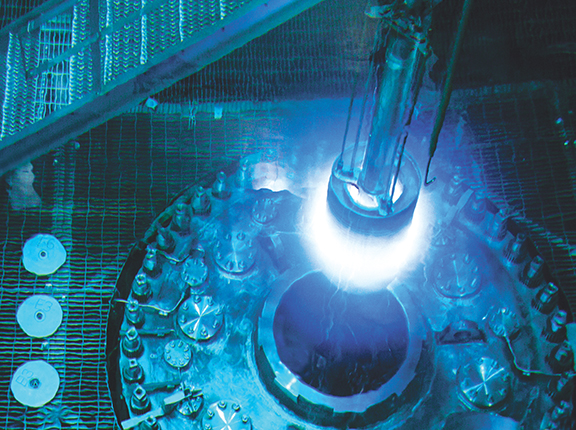Reactor conversions need time, not more money
DOI: 10.1063/PT.3.3134
Nearly a decade of development and performance evaluations of new nuclear fuels will be needed before work can begin on converting the remaining six US research reactors that use highly enriched uranium (HEU) to low-enriched uranium (LEU), Department of Energy officials say.
Research reactors that use HEU present a nuclear terrorism risk, since their fuel is enriched to up to 93% fissile uranium-235, sufficient for a nuclear explosive device. Research reactors, particularly those at universities, are lightly guarded compared with weapons facilities. Low-enriched uranium contains less than 20% 235U. Natural uranium contains 0.7% 235U.
Peter Hanlon, assistant deputy administrator for material management and minimization in DOE’s National Nuclear Security Administration, says the US reactor conversion process is set to occur between 2026 and 2032. By 2035 work on the two European reactors that use US-origin HEU should be completed. As recently as 2009, the NNSA had projected a 2018 completion date for the conversion program, but technical challenges have proven to be greater than anticipated, says Anne Harrington, NNSA deputy administrator for defense nuclear nonproliferation.
The US HEU-fueled reactors are located at MIT, the University of Missouri, NIST, and Oak Ridge and Idaho National Laboratories. The Missouri reactor is scheduled to be converted first; Oak Ridge’s High Flux Isotope Reactor will be last.

The High Flux Isotope Reactor at Oak Ridge National Laboratory is the highest-flux reactor-based source of neutrons for research in the US. It is scheduled to be converted from highly enriched uranium fuel to low-enriched uranium fuel in 2032, the last of six US research reactors scheduled to undergo the change.
COURTESY OF OAK RIDGE NATIONAL LABORATORY, US DEPARTMENT OF ENERGY

Belgium’s BR2 research reactor and France’s Institut Laue–Langevin neutron source are the only remaining non-US facilities fueled with US-origin HEU, Hanlon says. Canada’s National Research Universal reactor uses DOE-supplied HEU in the manufacturing of the medical isotope molybdenum-99. The Canadian reactor is to be shut down permanently in March 2018, officials have announced.
Worldwide, the NNSA has converted 68 HEU-fueled research reactors and one HEU-fueled 99Mo production facility since 1978. Its most recent conversion, of a Chinese prototype reactor, was completed in March. The agency has verified that another 26 HEU reactors were permanently shut down. The NNSA hopes to convert another 61 facilities around the globe by 2035.
“We’ve accomplished an enormous amount so far and we are very proud of what we’ve done, [but] a lot of what is left is really, really hard,” says Harrington. The US reactors were designed and built differently, and each conversion must be accomplished economically, she notes.
“The time that goes into this is experimentation, preparation, fabrication, experiments, and irradiation of materials,” Hanlon says. “It’s a set timeline, so pouring more money into it isn’t going to somehow get it done faster.”
Converting a reactor to LEU requires a fuel that has a higher density of uranium to offset LEU’s lower enrichment level. The NNSA program has selected a uranium–molybdenum alloy to replace the HEU fuel in the US reactors and is now evaluating different fuel fabrication technologies, Hanlon says.
Other conversions have used various LEU fuel types, including uranium aluminide, uranium oxide, uranium silicide, and uranium–zirconium hydride. Those fuels have been fabricated in different geometries, such as plates, rods, and tubes, an NNSA spokesperson says.
Delays were avoidable
Alan Kuperman, coordinator of the Nuclear Proliferation Prevention Project at the University of Texas at Austin, says that past mismanagement is partly responsible for the lengthy conversion time scale. DOE spent many years of R&D on concepts for fuels that ultimately couldn’t be fabricated.
But Kuperman lauds the NNSA and its European partners for their continuing commitment to conversion. Russia is the only nation not on course to eliminate HEU fuel from research reactors, he notes. Russia, however, has historically followed the global norm. According to the January report Reducing the Use of Highly Enriched Uranium in Civilian Research Reactors by the National Academies of Sciences, Engineering, and Medicine, Russia has converted all of the research reactors it had installed in countries outside the former Soviet Union. But the Russian government does not see the conversion of its domestic fleet of 41 HEU-fueled reactors as a priority, the report says.
The NNSA-developed fuel might be used to convert some Russian-origin research reactors, says Hanlon. But cooperative nonproliferation activities between the US and Russia have been suspended amid deteriorating relations.
The academies report lists two other US facilities not among those currently slated for conversion: the General Electric Nuclear Test Reactor in California and the Transient Reactor Test Facility (TREAT) at Idaho National Laboratory. Discussions between NNSA and GE officials have just recently begun, the report says, and TREAT is due to resume operating in 2018 and will convert once an LEU fuel becomes available.
Hanlon and Harrington declined to comment on the report’s recommendation that US reactors be fueled with 45% enriched uranium—half the 235U concentration of their current weapons-usable fuel—as an interim step until LEU fuel is available (see Physics Today, March 2016, page 27
Kuperman says moving to 45%-enriched fuel would undermine efforts to phase out HEU. Reactor operators would be loath to change fuels twice, and new reactors might be built to operate with the 45% material. In addition, he says, the NNSA’s Naval Nuclear Propulsion Program, which has just begun exploring the possibility of designing an LEU-fueled power plant for ships, wouldn’t use a fuel with a lower enrichment level than research reactors use.
More about the Authors
David Kramer. dkramer@aip.org




